Beat in English
2013.11.16 17:22
Silla: Korea’s Golden Kingdom@The Met Museum
조회 수 17557 댓글 0
*English Version
Silla: Korea’s Golden Kingdom
November 4, 2013~February 23, 2014
@Metropolitan Museum of Art
Story by Sukie Park, Translation by JuWon Park
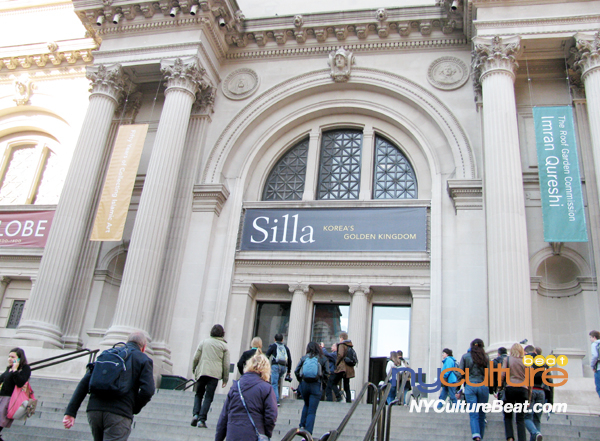
The Metropolitan Museum of Art finally unveiled “Silla: Korea’s Golden Kingdom” for media correspondents and the museum members on October 29th, before the exhibition was open to public on November 4th.
First time in the West to exclusively focus on the arts of Silla, Korea’s ancient kingdom dating from 57 B.C. to 935 A.D., this show is also the second largest on Korean ancient art to be presented in the U.S. after “5000 Years of Korean Art,” which travelled nation-wide in 1981.
The exhibition features 132 objects on loan from the National Museum of Korea and Gyeongju National Museum, including 10 spectacular objects classified as Korean National Treasures, with focus of era between A.D. 400 – 800.
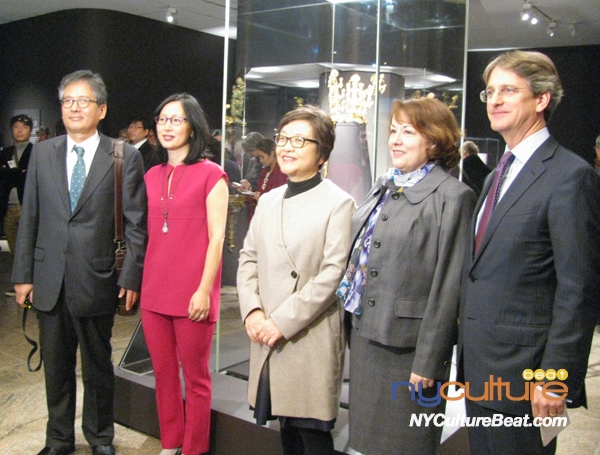
At the Opening Preview of “Silla.” From the left, Young-Hoon Lee, Director of the Gyeongju National Museum, SoYoung Lee, associate curator, YoungNa Lee, Director of the Natinoal Museum of Korea, Denise Leidy, curator of the Asian Art Department, and Thomas Campbell, Director of the Met.
As Thomas Campbell, Director and CEO of the Met, noted, this show is “not to be missed,” for it provides a rare opportunity to experience the visual wonder of the Silla dynasty. Indeed, curators SoYoung Lee and Denise Leidy managed to bring one of the most cherished treasures of Korea, the gilt-bronze bodhisattva, known as “National Treasure No. 83.”
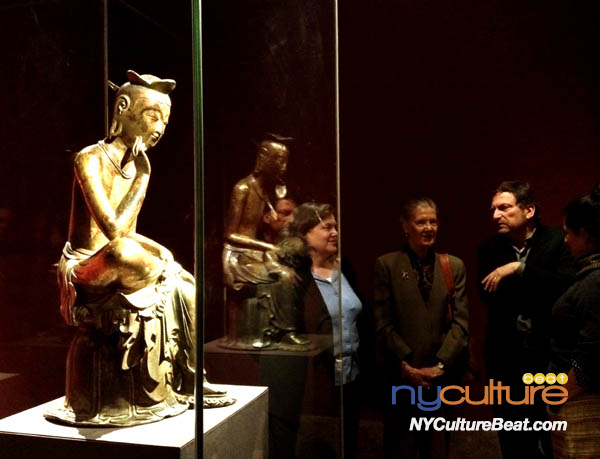
Now under high security, the Pensive Bodhisattva, revisits New York 56 years after it was shown as part of “5000 Years
of Korean Art.”
The bringing of this Pensive Bodhisattva initially seemed unlikely due to the Korean government’s reluctance to send the delicate statue abroad, after it was exhibited eight times, for over 3000 days total; it ultimately became possible after the Minister of Culture, Mr. Jin-Ryong Yoo, mediated in between last August. The 9th travel of “National Treasure 83” entailed triple wrapping with security escort as well as insurance worth of $50 million.
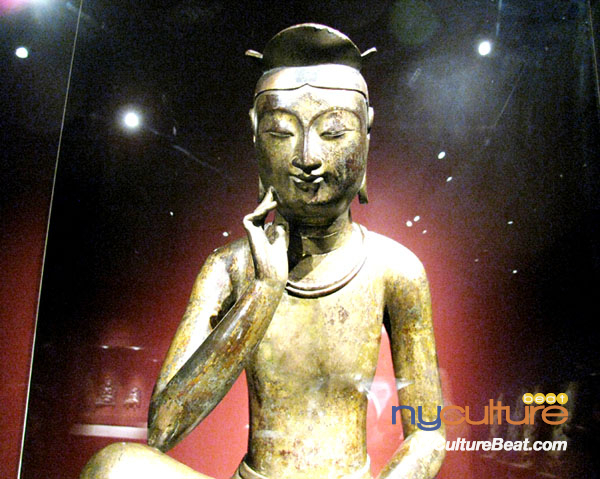
In displaying her delight, Curator SoYoung Lee said, “As challenging as it was to bring the Pensive Bodhisattva to New York, I am thrilled to introduce its beauty to the new audiences. This may be the sculpture’s last voyage.”
Highlights of “Silla: Korea's Golden Kingdom'
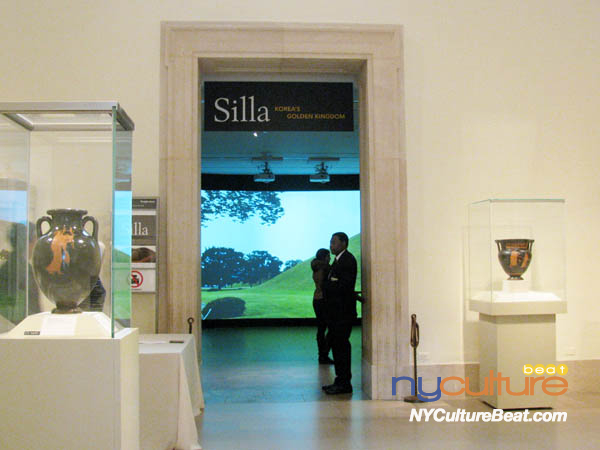
“Silla: Korea’s Golden Kingdom” is held at Gallery 199, the biggest space for special exhibitions located next to the Greco-Roman galleries.
The show is presented in three sections: The first part showcases the 5th – 6th century objects from royal and elite tombs; the second highlights the internationality of Silla’s culture; the third features the kingdom’s Buddhist art.
1. Burial Objects: Exploring the Culture of Silla Along with that of Horse-Riding
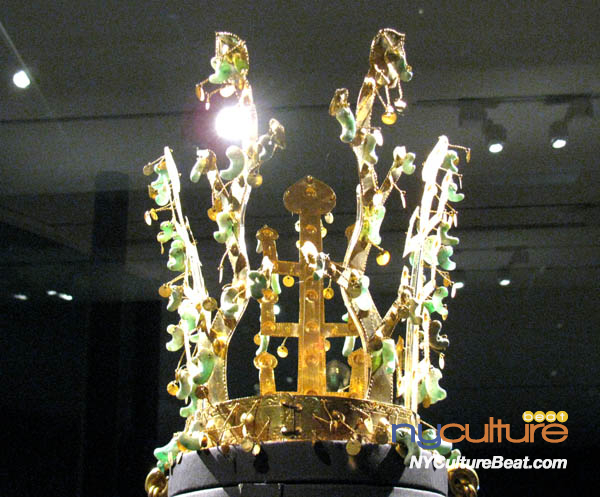
The Golden Crown (National Treasure No. 191) excavated from the Hwangnam Daechong Tomb.
The kingdom of Silla rose to prominence in the fifth century as the system of hereditary monarchy developed. Gold meant regal power. And yet, it still remains as a mystery how the people of Silla acquired the precious material, when there is no archeological evidence of mining gold. Despite the “no-gold-to-dig” possibility in the lands of Korea, the objects from burial sites boast craftsmanship so exquisite that it may be compared, if not surpass, to the modern expertise seen at Tiffany or Bulgari.
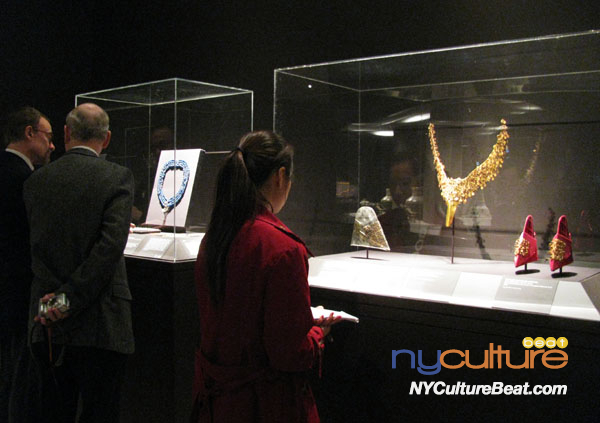
The most outstanding example of such artistry would be the golden crown, excavated from the Great Tomb of Hwangnam, which is one of the biggest tombs measuring over 260 feet in diameter and almost 400 feet in length. The royal crown is also archeologically significant for it is one of only five regalia found from Silla tombs. The rest of the displayed objects visually demonstrate how the local culture of Silla blended with that of horse-riding widespread in the Eurasian steppes.
Curator Denise Leidy jovially added, “This show may indirectly reveal the origin of PSY’s horse dance!”
Sponsored by Samsung, a video about the technique of gold production helps the visitors to better understand how golden jewelry would have been made.
2. Global Network of Silla
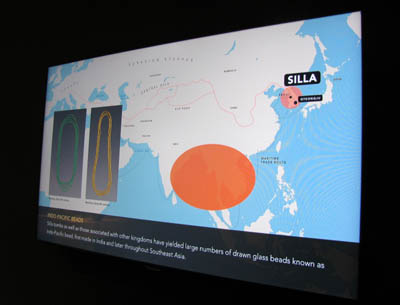 Indian beads were also imported to Silla.
Indian beads were also imported to Silla.Silla’s economic and cultural exchanges with Eurasia were galvanized in 668, when it unified much of the Korean peninsula. The second section explores the relics that were imported from abroad and characteristic of foreign motive or pattern. Based on the firm political ties and trade with Tang Dynasty China, Silla was able to consolidate a vast network of cultural exchanges with China, Persia, and beyond, via Silk Road. And such international transaction is evidently found in the works of ceramics, statues, and architectural components.
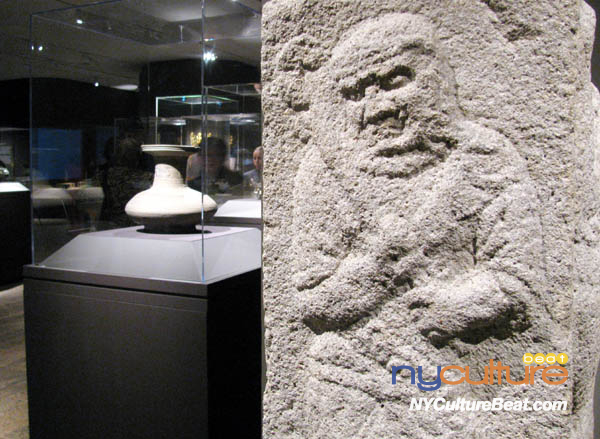
Some highlighted finds include: a unique silver bowl possibly from Central Asia or China; an inlaid-gold sheath, found in Gyeongju and supposedly of Uzbekistani origin; an imported ceramic of Tang sancai; a slab decorated with a Western Asian figure.
3. The art of Buddhism in Silla: Searching for the Unique Aesthetic
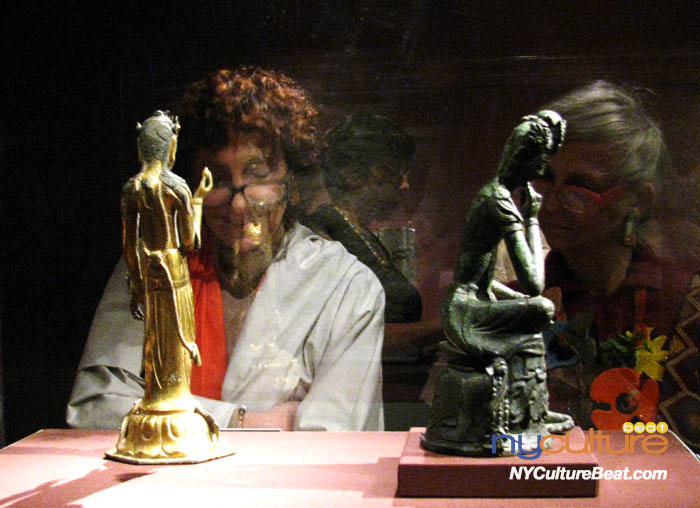
In 528, King Beopheung set Buddhism as the state religion, brining an immense socio-cultural transformation in burial rituals and artistic traditions. And it is gold that most clearly demonstrates this cultural shift. The famous Pensive Bodhisattva (a.k.a. the National Treasure 83) reflects the zenith of artistic achievements spurred by the newly brought religion.
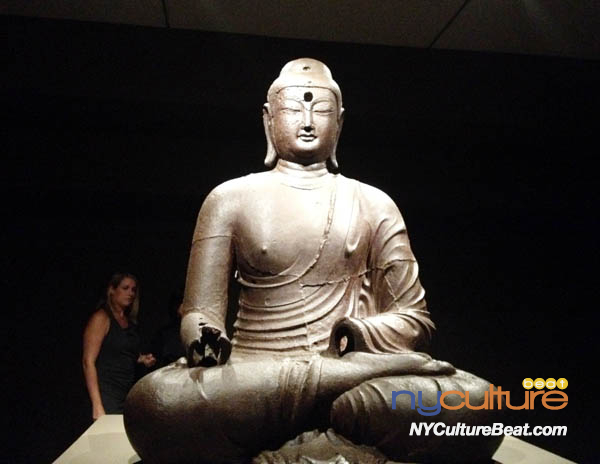
Buddha statue from Bowonsa Temple site, Seosan, South Chungcheong province. Cast iron, 150cm.
It is interesting to see the way in which Korea Buddhist art reflects the pan-Asian nature of Buddhism, by reinterpreting styles of China and Southern Asia, while simultaneously keeping a distinctively native aesthetic. The exhibition offers a wonderful chance to explore the blended religious imageries found in Korea, China and Southern Asia, as exemplified in the golden Buddha (National Treasure 79) from the pagoda at Hwangboksa Temple site.
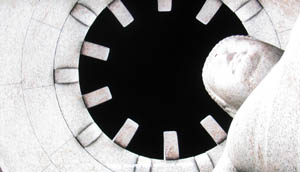
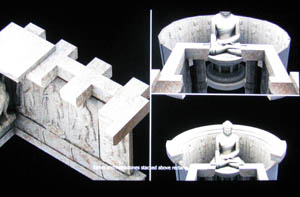
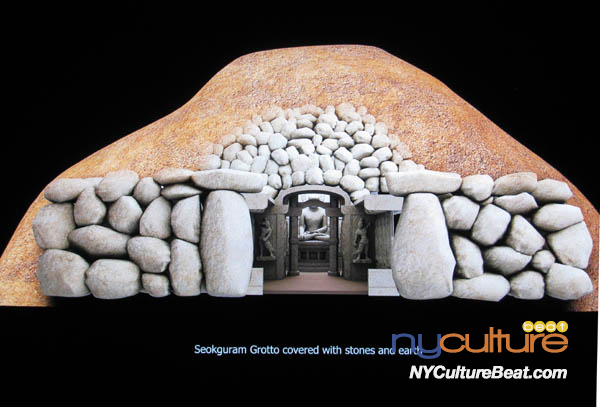
A part of the 4-minute long 3D video on the structure of Seokguram Grotto, an 8th-century artificial stone cave that represents the pinnacle of Silla architecture. It has been designated as National Treasure and UNESCO World Heritage Site.
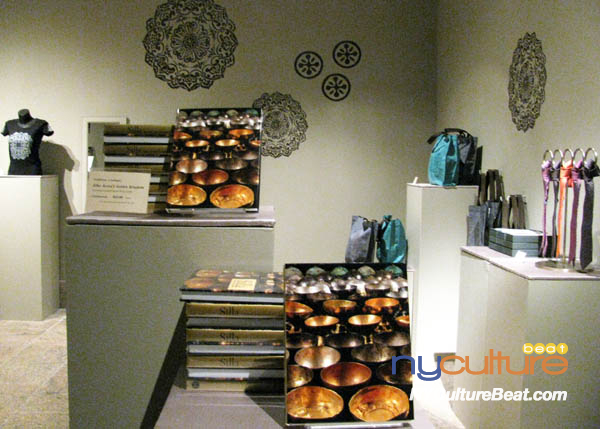
Enjoy the show’s final stop at the gift shop, which has exhibition catalogues ($65), canvas totes, T-shirts, etc.
Also fun to note: Inspired by the Silla exhibition, the Museum cafeteria will be having special menu items, such as grilled Tilapia fillet, chicken Bulgogi, Kimchi fried rice, steamed Napa cabbage, and assorted Banchan.
The show runs until Feb. 23rd, 2014. http://www.metmuseum.org
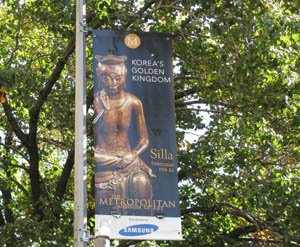
Below is more information about the programs, exhibition credits, catalogue and audio guide from the Met’s press release:
Digital Programs
The exhibition galleries include a range of digital presentations to enhance the visitors’ experience and appreciation of the art, including videos featuring 3D reconstructions of the Great Tomb of Hwangnam and the Seogkuram Grotto, a UNESCO World Heritage Monument. In addition, an interactive display allows viewers to examine closely a spectacular pair of earrings while explaining some of the techniques used in the production of the earrings and other gold adornments in the exhibition. The technology is courtesy of Samsung.
Catalogue
In conjunction with the exhibition, the Museum has published a fully illustrated catalogue with eight essays written by a team of Korean and Western scholars, providing an important
English-language publication on Silla art and culture.
The catalogue is made possible by the Korea Foundation, The Kun-Hee Lee Fund for Korean Art, and Grace I. Kim and Family.
Exhibition Credits
The exhibition is organized by Soyoung Lee, Associate Curator, and Denise Leidy, Curator, both of the Department of Asian Art at The Metropolitan Museum of Art, in collaboration with colleagues at The National Museum of Korea, Seoul, and Gyeongju National Museum, Korea. The exhibition designer is Michael Lapthorn; graphics were designed by Kamomi Solidum with Norie Morimoto and Sue Koch; and lighting design is by Richard Lichte and Clint Coller, all of the Metropolitan Museum’s Design Department.
Education Programs
In conjunction with the exhibition, the Museum will offer a variety of programs. Highlights include: a November 17 Sunday at the Met program of lectures complemented by a live demonstration of goldworking techniques; a December 4 Gallery Conversation between a curator and an archaeologist about the nomadic cultures of Eurasia and regalia found in tombs of the Silla Kingdom; A Day of Activities for Families on January 26 exploring ancient wonders from Korea through tours and art-making activities; Lunar New Year Festival on February 8; and a ticketed event called Spark: From Silla to K-Pop on February 12 in the Metropolitan Museum’s Grace Rainey Rogers Auditorium ($30). In addition, six gallery talks will focus on the exhibition and on the themes of tomb culture and sacred monuments, and the spread of Buddhism throughout Asia.
Audio Guide
An audio tour narrated by the exhibition’s curators—part of the Museum’s Audio Guide program—provides additional contextual information about Silla and its artistic heritage. It is available for rental ($7, $6 for Members, $5 for children under 12).







